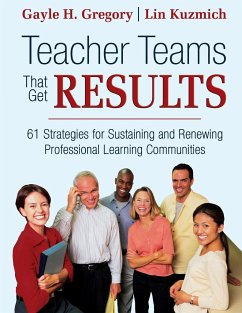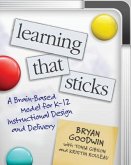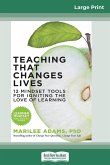Gayle H. Gregory, Lin Kuzmich
Teacher Teams That Get Results
61 Strategies for Sustaining and Renewing Professional Learning Communities
Gayle H. Gregory, Lin Kuzmich
Teacher Teams That Get Results
61 Strategies for Sustaining and Renewing Professional Learning Communities
- Broschiertes Buch
- Merkliste
- Auf die Merkliste
- Bewerten Bewerten
- Teilen
- Produkt teilen
- Produkterinnerung
- Produkterinnerung
A comprehensive set of tools for achieving lasting results and sustaining a professional learning community! To help sustain the ongoing success of professional learning communities, this comprehensive resource provide
Andere Kunden interessierten sich auch für
![Mentoring and Induction Programs That Support New Principals Mentoring and Induction Programs That Support New Principals]() Susan VillaniMentoring and Induction Programs That Support New Principals45,99 €
Susan VillaniMentoring and Induction Programs That Support New Principals45,99 €![International Beliefs and Practices That Characterize Teacher Effectiveness International Beliefs and Practices That Characterize Teacher Effectiveness]() International Beliefs and Practices That Characterize Teacher Effectiveness175,99 €
International Beliefs and Practices That Characterize Teacher Effectiveness175,99 €![Be THAT teacher Be THAT teacher]() Dwayne ReedBe THAT teacher25,99 €
Dwayne ReedBe THAT teacher25,99 €![International Beliefs and Practices That Characterize Teacher Effectiveness International Beliefs and Practices That Characterize Teacher Effectiveness]() International Beliefs and Practices That Characterize Teacher Effectiveness226,99 €
International Beliefs and Practices That Characterize Teacher Effectiveness226,99 €![Learning That Sticks Learning That Sticks]() Bryan GoodwinLearning That Sticks32,99 €
Bryan GoodwinLearning That Sticks32,99 €![Teaching That Changes Lives Teaching That Changes Lives]() Marilee AdamsTeaching That Changes Lives31,99 €
Marilee AdamsTeaching That Changes Lives31,99 €![Creating Professional Development That Works Creating Professional Development That Works]() Andrea L. RayCreating Professional Development That Works124,99 €
Andrea L. RayCreating Professional Development That Works124,99 €-
-
-
A comprehensive set of tools for achieving lasting results and sustaining a professional learning community! To help sustain the ongoing success of professional learning communities, this comprehensive resource provide
Hinweis: Dieser Artikel kann nur an eine deutsche Lieferadresse ausgeliefert werden.
Hinweis: Dieser Artikel kann nur an eine deutsche Lieferadresse ausgeliefert werden.
Produktdetails
- Produktdetails
- Verlag: Corwin
- Seitenzahl: 282
- Erscheinungstermin: 9. Januar 2007
- Englisch
- Abmessung: 280mm x 216mm x 15mm
- Gewicht: 717g
- ISBN-13: 9781412926133
- ISBN-10: 1412926130
- Artikelnr.: 21411580
- Herstellerkennzeichnung
- Libri GmbH
- Europaallee 1
- 36244 Bad Hersfeld
- gpsr@libri.de
- Verlag: Corwin
- Seitenzahl: 282
- Erscheinungstermin: 9. Januar 2007
- Englisch
- Abmessung: 280mm x 216mm x 15mm
- Gewicht: 717g
- ISBN-13: 9781412926133
- ISBN-10: 1412926130
- Artikelnr.: 21411580
- Herstellerkennzeichnung
- Libri GmbH
- Europaallee 1
- 36244 Bad Hersfeld
- gpsr@libri.de
Gayle Gregory is an internationally known consultant who has specialized in brain compatible learning and differentiated instruction and assessment. She presents practical teacher/student-friendly strategies grounded in sound research that educators find easy to use in the classroom or schoolhouse tomorrow. Her interactive style and modeling of strategies help teachers and administrators transfer new ideas with ease. She has had extensive experience in elementary, middle and secondary schools, community colleges and universities. Gayle has also had district leadership roles including curriculum coordinator and staff development director. She has worked with Instructional Leadership Teams in many schools and district throughout the country focusing on data analysis, using assessment, both formative and summative, and differentiating instruction based on readiness, learning profiles and interests. Her areas of expertise include brain-compatible learning, block scheduling, emotional intelligence, instructional and assessment practices, differentiated instructional strategies, using data to differentiate, literacy, presentation skills, renewal of secondary schools, enhancing teacher quality, coaching and mentoring, managing change and building professional learning communities. Gayle is affiliated with many organizations, such as the Association for Supervision and Curriculum Development and the National Staff Development Council. She is the author and co-author of numerous publications for teachers and administrators. Gayle believes in life long learning for herself and others.
Acknowledgments
About the Authors
Introduction: Tools That Get Results
Purpose for This Book
What We Know About Adult Learning
Brain Bits
Adult Learning Principles
Learning Styles
What Different Learners Need
Initial Group Development
Phases of Group Development and Behaviors
Benefit of Professional Learning Communities
Getting the Intended Results
Learning Teams That Get Results
Tools to Succeed as Teams
In This Book
1. Creating a Growth Oriented Culture
Strategy 1. ABC Conversations
Strategy 2: Birthday Month
Strategy 3: Community Circle
Strategy 4: Concept Formation
Strategy 5: Consultation Line
Strategy 6: Find Someone Who
Strategy 7: Four Corners
Strategy 8: Give and Go
Strategy 9: Mapping the Journey
Strategy 10: 3-2-1
Strategy 11: Nominal Group Process
Strategy 12: Personal, Interpersonal, Task Model (P.I.T.)
Strategy 13: Processing Pause
Strategy 14: Random Partners
Strategy 15:Synectics
Strategy 16:T Chart and Y Chart
2. Sharing Knowledge and Skills
Strategy 17: DIP Party
Strategy 18: Four Corner Cards
Strategy 19: Inside Outside Circle
Strategy 20: Jigsaw
Strategy 21: Know, Want to Know, Learned (KWL)
Strategy 22: Perspective Lens
Strategy 23: Pluses and Wishes
Strategy 24: Plus, Minus, Interesting
Strategy 25: Promissory Note
Strategy 26: Right Angle
Strategy 27: Round Robin, Round Table
Strategy 28: Round the Room Brainstorming
Strategy 29: Star Gazing
Strategy 30: Think, Pair, Share
Strategy 31: Wallpaper Poster
3. Building Resilience and Creating Solutions
Strategy 32: Checking the Oil
Strategy 33: Communication Matters
Strategy 34: Doubling Up
Strategy 35: Environmental Scanning
Strategy 36: Field Force
Strategy 37: FLOW
Strategy 38: Gallery Walk
Strategy 39: Graffiti
Strategy 40: Hot Buttons
Strategy 41: Journey Mapping (Also Known as Histo-Mapping)
Strategy 42: Musical Chairs
Strategy 43: Parking Lot
Strategy 44: Roadblock Removal
Strategy 45: The Question Matters: Reviewing Student Work
Strategy 46: Two Sides of the Story
4. Determining Priorities and Creating Excellence
Strategy 47: Building on Success
Strategy 48: Cause and Effect Planning
Strategy 49: Celebrations and Next Steps
Strategy 50: Current Snapshot
Strategy 51: Four Squares for Creativity
Strategy 52: Lesson and Unit Studies
Strategy 53: Prioritizing the Impact of Solutions
Strategy 54: Prioritizing Work and Learning
Strategy 55: Probable and Preferred Future
Strategy 56: Pros and Cons
Strategy 57: Strengths, Weaknesses, Opportunities, and Threats
Strategy 58: The Interview
Strategy 59: The People Ladder
Strategy 60: Think Abouts...
Strategy 61: Data Chats
5. Putting It All Together
Part One: Initial Group Development
Part Two: Sustaining Groups Over Time and Through New Initiatives
Putting It All Together: Examples for Implementation
Keeping Notes, Logging, and Our Methods
Keeping Your School, Team Culture, and Climate Healthy
Summary
References
Index
About the Authors
Introduction: Tools That Get Results
Purpose for This Book
What We Know About Adult Learning
Brain Bits
Adult Learning Principles
Learning Styles
What Different Learners Need
Initial Group Development
Phases of Group Development and Behaviors
Benefit of Professional Learning Communities
Getting the Intended Results
Learning Teams That Get Results
Tools to Succeed as Teams
In This Book
1. Creating a Growth Oriented Culture
Strategy 1. ABC Conversations
Strategy 2: Birthday Month
Strategy 3: Community Circle
Strategy 4: Concept Formation
Strategy 5: Consultation Line
Strategy 6: Find Someone Who
Strategy 7: Four Corners
Strategy 8: Give and Go
Strategy 9: Mapping the Journey
Strategy 10: 3-2-1
Strategy 11: Nominal Group Process
Strategy 12: Personal, Interpersonal, Task Model (P.I.T.)
Strategy 13: Processing Pause
Strategy 14: Random Partners
Strategy 15:Synectics
Strategy 16:T Chart and Y Chart
2. Sharing Knowledge and Skills
Strategy 17: DIP Party
Strategy 18: Four Corner Cards
Strategy 19: Inside Outside Circle
Strategy 20: Jigsaw
Strategy 21: Know, Want to Know, Learned (KWL)
Strategy 22: Perspective Lens
Strategy 23: Pluses and Wishes
Strategy 24: Plus, Minus, Interesting
Strategy 25: Promissory Note
Strategy 26: Right Angle
Strategy 27: Round Robin, Round Table
Strategy 28: Round the Room Brainstorming
Strategy 29: Star Gazing
Strategy 30: Think, Pair, Share
Strategy 31: Wallpaper Poster
3. Building Resilience and Creating Solutions
Strategy 32: Checking the Oil
Strategy 33: Communication Matters
Strategy 34: Doubling Up
Strategy 35: Environmental Scanning
Strategy 36: Field Force
Strategy 37: FLOW
Strategy 38: Gallery Walk
Strategy 39: Graffiti
Strategy 40: Hot Buttons
Strategy 41: Journey Mapping (Also Known as Histo-Mapping)
Strategy 42: Musical Chairs
Strategy 43: Parking Lot
Strategy 44: Roadblock Removal
Strategy 45: The Question Matters: Reviewing Student Work
Strategy 46: Two Sides of the Story
4. Determining Priorities and Creating Excellence
Strategy 47: Building on Success
Strategy 48: Cause and Effect Planning
Strategy 49: Celebrations and Next Steps
Strategy 50: Current Snapshot
Strategy 51: Four Squares for Creativity
Strategy 52: Lesson and Unit Studies
Strategy 53: Prioritizing the Impact of Solutions
Strategy 54: Prioritizing Work and Learning
Strategy 55: Probable and Preferred Future
Strategy 56: Pros and Cons
Strategy 57: Strengths, Weaknesses, Opportunities, and Threats
Strategy 58: The Interview
Strategy 59: The People Ladder
Strategy 60: Think Abouts...
Strategy 61: Data Chats
5. Putting It All Together
Part One: Initial Group Development
Part Two: Sustaining Groups Over Time and Through New Initiatives
Putting It All Together: Examples for Implementation
Keeping Notes, Logging, and Our Methods
Keeping Your School, Team Culture, and Climate Healthy
Summary
References
Index
Acknowledgments
About the Authors
Introduction: Tools That Get Results
Purpose for This Book
What We Know About Adult Learning
Brain Bits
Adult Learning Principles
Learning Styles
What Different Learners Need
Initial Group Development
Phases of Group Development and Behaviors
Benefit of Professional Learning Communities
Getting the Intended Results
Learning Teams That Get Results
Tools to Succeed as Teams
In This Book
1. Creating a Growth Oriented Culture
Strategy 1. ABC Conversations
Strategy 2: Birthday Month
Strategy 3: Community Circle
Strategy 4: Concept Formation
Strategy 5: Consultation Line
Strategy 6: Find Someone Who
Strategy 7: Four Corners
Strategy 8: Give and Go
Strategy 9: Mapping the Journey
Strategy 10: 3-2-1
Strategy 11: Nominal Group Process
Strategy 12: Personal, Interpersonal, Task Model (P.I.T.)
Strategy 13: Processing Pause
Strategy 14: Random Partners
Strategy 15:Synectics
Strategy 16:T Chart and Y Chart
2. Sharing Knowledge and Skills
Strategy 17: DIP Party
Strategy 18: Four Corner Cards
Strategy 19: Inside Outside Circle
Strategy 20: Jigsaw
Strategy 21: Know, Want to Know, Learned (KWL)
Strategy 22: Perspective Lens
Strategy 23: Pluses and Wishes
Strategy 24: Plus, Minus, Interesting
Strategy 25: Promissory Note
Strategy 26: Right Angle
Strategy 27: Round Robin, Round Table
Strategy 28: Round the Room Brainstorming
Strategy 29: Star Gazing
Strategy 30: Think, Pair, Share
Strategy 31: Wallpaper Poster
3. Building Resilience and Creating Solutions
Strategy 32: Checking the Oil
Strategy 33: Communication Matters
Strategy 34: Doubling Up
Strategy 35: Environmental Scanning
Strategy 36: Field Force
Strategy 37: FLOW
Strategy 38: Gallery Walk
Strategy 39: Graffiti
Strategy 40: Hot Buttons
Strategy 41: Journey Mapping (Also Known as Histo-Mapping)
Strategy 42: Musical Chairs
Strategy 43: Parking Lot
Strategy 44: Roadblock Removal
Strategy 45: The Question Matters: Reviewing Student Work
Strategy 46: Two Sides of the Story
4. Determining Priorities and Creating Excellence
Strategy 47: Building on Success
Strategy 48: Cause and Effect Planning
Strategy 49: Celebrations and Next Steps
Strategy 50: Current Snapshot
Strategy 51: Four Squares for Creativity
Strategy 52: Lesson and Unit Studies
Strategy 53: Prioritizing the Impact of Solutions
Strategy 54: Prioritizing Work and Learning
Strategy 55: Probable and Preferred Future
Strategy 56: Pros and Cons
Strategy 57: Strengths, Weaknesses, Opportunities, and Threats
Strategy 58: The Interview
Strategy 59: The People Ladder
Strategy 60: Think Abouts...
Strategy 61: Data Chats
5. Putting It All Together
Part One: Initial Group Development
Part Two: Sustaining Groups Over Time and Through New Initiatives
Putting It All Together: Examples for Implementation
Keeping Notes, Logging, and Our Methods
Keeping Your School, Team Culture, and Climate Healthy
Summary
References
Index
About the Authors
Introduction: Tools That Get Results
Purpose for This Book
What We Know About Adult Learning
Brain Bits
Adult Learning Principles
Learning Styles
What Different Learners Need
Initial Group Development
Phases of Group Development and Behaviors
Benefit of Professional Learning Communities
Getting the Intended Results
Learning Teams That Get Results
Tools to Succeed as Teams
In This Book
1. Creating a Growth Oriented Culture
Strategy 1. ABC Conversations
Strategy 2: Birthday Month
Strategy 3: Community Circle
Strategy 4: Concept Formation
Strategy 5: Consultation Line
Strategy 6: Find Someone Who
Strategy 7: Four Corners
Strategy 8: Give and Go
Strategy 9: Mapping the Journey
Strategy 10: 3-2-1
Strategy 11: Nominal Group Process
Strategy 12: Personal, Interpersonal, Task Model (P.I.T.)
Strategy 13: Processing Pause
Strategy 14: Random Partners
Strategy 15:Synectics
Strategy 16:T Chart and Y Chart
2. Sharing Knowledge and Skills
Strategy 17: DIP Party
Strategy 18: Four Corner Cards
Strategy 19: Inside Outside Circle
Strategy 20: Jigsaw
Strategy 21: Know, Want to Know, Learned (KWL)
Strategy 22: Perspective Lens
Strategy 23: Pluses and Wishes
Strategy 24: Plus, Minus, Interesting
Strategy 25: Promissory Note
Strategy 26: Right Angle
Strategy 27: Round Robin, Round Table
Strategy 28: Round the Room Brainstorming
Strategy 29: Star Gazing
Strategy 30: Think, Pair, Share
Strategy 31: Wallpaper Poster
3. Building Resilience and Creating Solutions
Strategy 32: Checking the Oil
Strategy 33: Communication Matters
Strategy 34: Doubling Up
Strategy 35: Environmental Scanning
Strategy 36: Field Force
Strategy 37: FLOW
Strategy 38: Gallery Walk
Strategy 39: Graffiti
Strategy 40: Hot Buttons
Strategy 41: Journey Mapping (Also Known as Histo-Mapping)
Strategy 42: Musical Chairs
Strategy 43: Parking Lot
Strategy 44: Roadblock Removal
Strategy 45: The Question Matters: Reviewing Student Work
Strategy 46: Two Sides of the Story
4. Determining Priorities and Creating Excellence
Strategy 47: Building on Success
Strategy 48: Cause and Effect Planning
Strategy 49: Celebrations and Next Steps
Strategy 50: Current Snapshot
Strategy 51: Four Squares for Creativity
Strategy 52: Lesson and Unit Studies
Strategy 53: Prioritizing the Impact of Solutions
Strategy 54: Prioritizing Work and Learning
Strategy 55: Probable and Preferred Future
Strategy 56: Pros and Cons
Strategy 57: Strengths, Weaknesses, Opportunities, and Threats
Strategy 58: The Interview
Strategy 59: The People Ladder
Strategy 60: Think Abouts...
Strategy 61: Data Chats
5. Putting It All Together
Part One: Initial Group Development
Part Two: Sustaining Groups Over Time and Through New Initiatives
Putting It All Together: Examples for Implementation
Keeping Notes, Logging, and Our Methods
Keeping Your School, Team Culture, and Climate Healthy
Summary
References
Index








